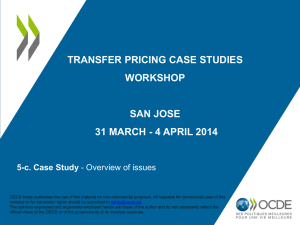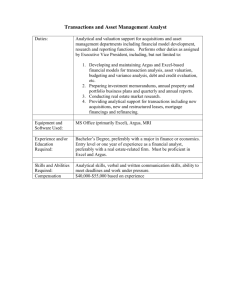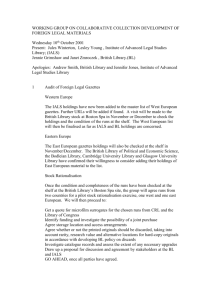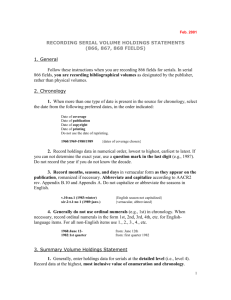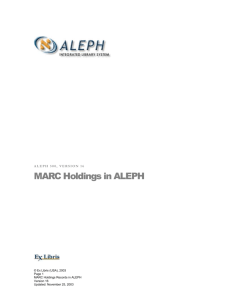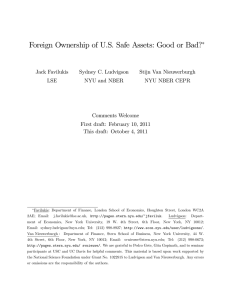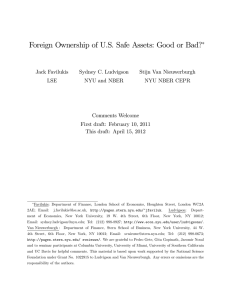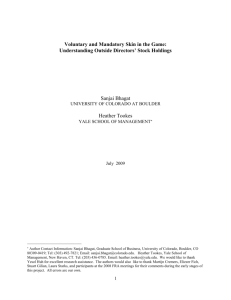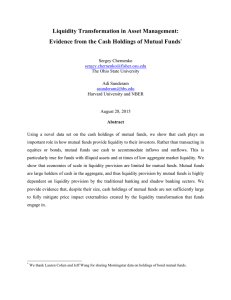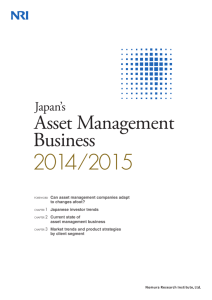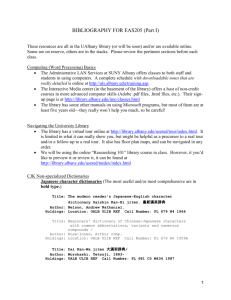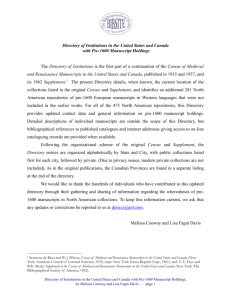Land Assembly Plan - Department of Treasury
advertisement
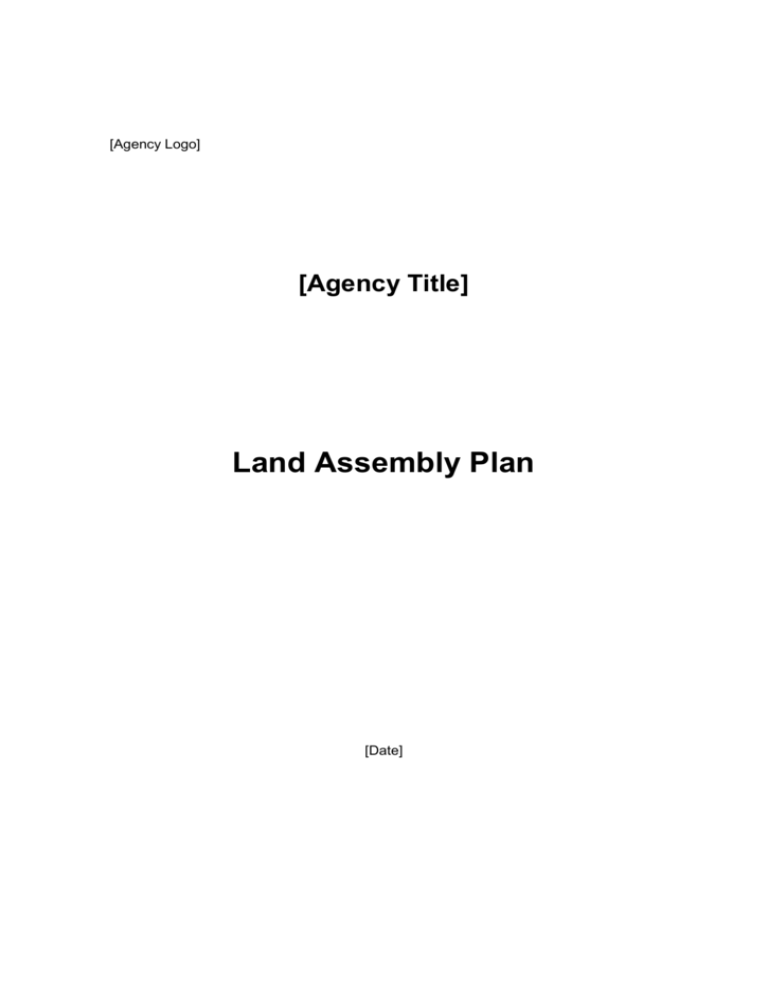
[Agency Logo] [Agency Title] Land Assembly Plan [Date] Approval Name/Title Signature Date Chief Executive Officer Chief Finance Officer Senior Asset Manager Other Contact Officer Name/Title Email Phone Version Control Version Draft 1 Draft 2 Final Date Status/Action/Change Approved By Executive Summary This section summarises the main results and advice from the land assembly plan and lists the recommendations for which approval is sought from decision-makers. Advice is provided on the: context and strategic priority for land enhancements, acquisitions and transfers over the next ten years; agency’s existing and proposed land holdings for the short, medium and long term, and why they will be important for the success of its service delivery model; why the proposed holdings would reflect cost effective investment in government and private land; and the next steps, such as for renewed stakeholder engagement, and the development of an application for concept approval to improve an existing land holding, or to acquire a new one. The information in the remainder of the land assembly plan provides the necessary backing. Strategic Outlook Overview This section provides an overview of the future land component of an agency’s service delivery model as outlined in its strategic asset plan; including both existing land that should be retained and new land to be acquired. A strategic asset plan clarifies the asset-related demand drivers, service delivery objectives and model for an individual agency, and for the agency in cooperation with others. This provides the point of reference for a strategic approach to the land assets that should be retained and enhanced, or acquired over the next ten years. For example, if an agency intends to consolidate various facilities to a single location, its land holdings will change gradually from small, scattered areas to a large central location. The land assembly plan does not repeat the detail in the Service Delivery Model section of the strategic asset plan. Instead, clear advice is provided on the land that will be needed, the reasons, and the timing for the transition from current to future land holdings. 1 To support the proposed holdings and acquisitions, advice is provided on their consistency with long-term State plans for urban and regional development; for example, in terms of their proximity to, synergies with, and impacts on future population centres, transport corridors and heavy industrial areas. Questions How consistent would each site be with long-term State plans for urban and regional development? Why are any inconsistencies unavoidable and justified in terms, for example, of the agency’s objectives, or the costs and benefits? Evidence Cross-references are provided to the parts of an agency’s strategic asset plan, and to the State urban and region plans, that were used to define the land holdings. Land Elements This part focuses on the individual, major elements in an agency’s future land holdings that would be: retained; obtained from another agency; and acquired on the private market. By clarifying its major land sites well in advance, an agency increases the prospect that it will acquire the right land on time at a fair market price and with the greatest likelihood of achieving value for money. This in turn enables the early preparation of well-targeted asset investment proposals in applications for concept approval. For each major proposal, a table similar to the following is used to convey the essential aspects: Site A Details Location Size Purpose Special Attributes (e.g. Access) Timelines for Delivery Consistency with State Planning Advice is also provided on the costs and benefits associated with each major land element, as outlined in the remaining sections of this model. 2 Section One: Retained Land This section focuses on the major land elements that an agency intends to retain as part of its service delivery model. The broad costs and benefits are explained. For example, the benefits may include proximity to future growth centres, or the potential for development on-site or on adjacent sites. Costs may include on-going maintenance of an unused part of the land. Questions How would each site form an effective part of an agency’s service delivery model over the short, medium or long-term? Why should the existing land be retained and perhaps enhanced for future use? Section Two: Other Government Land This section clarifies the broad benefits and costs of acquiring land held by other agencies. To complete this section, an agency contacts the Land Asset Management Unit (in the Department of Lands) to check whether potential sites have been identified for disposal by another agency. An agency also contacts other agencies that hold land in the vicinity of its future land holdings. Questions What due diligence was done to check whether other agencies may have suitable vacant, surplus or underperforming land? Why are the most promising government sites not suitable; for example, because a transfer would not be possible at a mutually agreeable time? Evidence Information is available on the liaison conducted with the Land Asset Management Unit and other agencies to seek government land purchase opportunities. 3 Section Three: Private Land This section focuses on the private land that may form part of an agency’s service delivery model, and for which the investment of State funds would be required. A compelling proposition is required, given the principle that private land should only be considered if no suitable government land is available. The imperatives and the broad costs and benefits are explained. For example, the benefits may include the prevention of encroachments on land that will be essential for future services, and the need to acquire the land before its value escalates as projected by independent market analysts. Questions Why is the acquisition of private land unavoidable? How will a fair price and value for money be obtained? If available, should the resumption option (compulsory acquisition) be considered now or later? Section Four: Summary This section summarises the land elements. A pie graph is used to show the relative extent of the elements, for example, that private land would be approximately thirty percent of the total. A brief explanation clarifies why these proportions represent the most cost effective approach. Questions 4 What percentage of the property portfolio will contribute directly to service delivery in the short-term (1-4 years), medium-term (5-10 years) and long-term (20 years)? What proportion of the future service delivery model will be located on land acquired from the private sector, compared to retained land and to acquisitions from other agencies? Why do the investment proportions reflect the efficient use of State funds?





